单节1A锂电充电IC M1056
- 格式:docx
- 大小:31.95 KB
- 文档页数:2
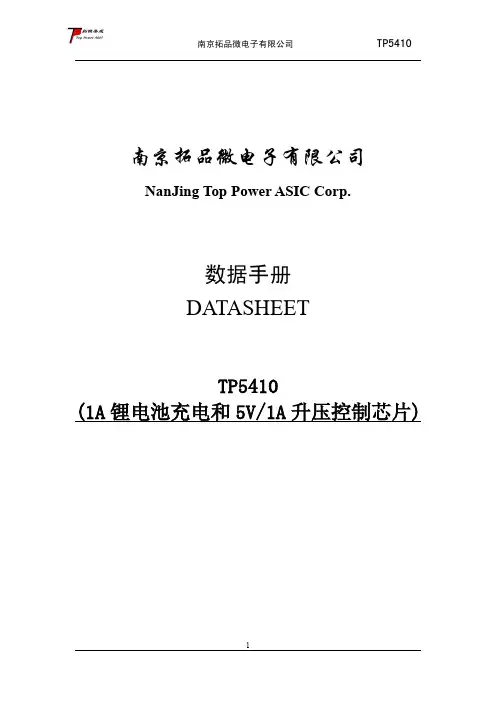
南京拓品微电子有限公司NanJing Top Power ASIC Corp.数据手册DATASHEETTP5410(1A锂电池充电和5V/1A升压控制芯片)特点★典型值高达1000mA 的可编程充电电流,最大可达到1.2A;★高达1A 的升压输出电流(Vbat=3.3V),最高输出1.5A(Vbat=3.8v);★自动频率调整(VFM),适应不同升压负载(5V空载待机电流小于10uA),无需按键启动低电池电压(小于2.7V)自动停止升压;·用于单节锂离子电池移动电源专用电路;·升压高效率:88%(Typ),最大92%;·恒定电流/恒定电压操作,并具有可在无过热危险的情况下实现充电速率最大化的热调节功能;·精度达到±1%的4.2V 预设充电电压;·精度达到±2.5%的5V 预设升压精度,5V 电压可通过外接电阻微调;·最高输入可达10V;·2个充电状态指示:开漏输出驱动LED;·C/5充电终止电流;·2.9V以下涓流充C/5;·充电软启动减少浪涌电流;·无需MOSFET 、检测电阻器或隔离二极管;·8引脚ESOP 散热加强型封装。
应用·移动电源·便携设备绝对最大额定值·输入电源电压(V CC ):-0.3V~12V ·PROG :-0.3V~V CC +0.3V ·BAT :0V~7V·LX :-2V~10V ·VOUT :-0.3V~10V ·CHRG :-0.3V~10V ·BAT 短路持续时间:连续·BAT 引脚电流:1200mA·升压最大输出电流1.8A/5V·最大结温:145℃·工作环境温度范围:-40℃~85℃·贮存温度范围:-65℃~125℃·引脚温度(焊接时间10秒):260℃完整的充电循环(1000mAh电池)描述TP5410为一款移动电源专用的单节锂离子电池充电器和恒定5V 升压控制器,充电部分集高精度电压和充电电流调节器、预充、充电状态指示和充电截止等功能于一体,可以输出最大1A 充电电流。
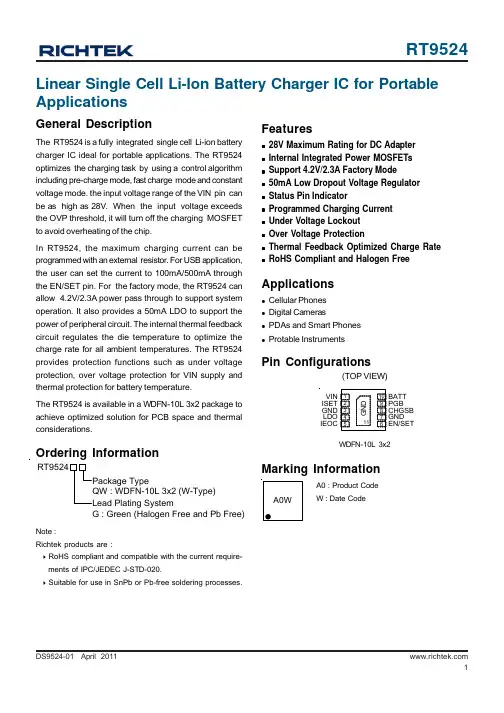
DS9524-01 April 2011Ordering InformationNote :Richtek products are :` RoHS compliant and compatible with the current require-ments of IPC/JEDEC J-STD-020.` Suitable for use in SnPb or Pb-free soldering processes.Pin ConfigurationsWDFN-10L 3x2(TOP VIEW)Linear Single Cell Li-Ion Battery Charger IC for Portable ApplicationsGeneral DescriptionThe RT9524 is a fully integrated single cell Li-ion battery charger IC ideal for portable applications. The RT9524optimizes the charging task by using a control algorithm including pre-charge mode, fast charge mode and constant voltage mode. the input voltage range of the VIN pin can be as high as 28V. When the input voltage exceeds the OVP threshold, it will turn off the charging MOSFET to avoid overheating of the chip.In RT9524, the maximum charging current can be programmed with an external resistor. For USB application,the user can set the current to 100mA/500mA through the EN/SET pin. For the factory mode, the RT9524 can allow 4.2V/2.3A power pass through to support system operation. It also provides a 50mA LDO to support the power of peripheral circuit. The internal thermal feedback circuit regulates the die temperature to optimize the charge rate for all ambient temperatures. The RT9524provides protection functions such as under voltage protection, over voltage protection for VIN supply and thermal protection for battery temperature.The RT9524 is available in a WDFN-10L 3x2 package to achieve optimized solution for PCB space and thermal considerations.Featuresz 28V Maximum Rating for DC Adapter z Internal Integrated Power MOSFETs z Support 4.2V/2.3A Factory Modez 50mA Low Dropout Voltage Regulator z Status Pin Indicatorz Programmed Charging Current z Under Voltage Lockout z Over Voltage Protectionz Thermal Feedback Optimized Charge Rate zRoHS Compliant and Halogen FreeApplicationsz Cellular Phones z Digital Camerasz PDAs and Smart Phones zProtable InstrumentsMarking InformationA0 : Product CodeW : Date CodeISET IEOCGND PGB CHGSB GND EN/SETLDOVIN BATT G : Green (Halogen Free and Pb Free)Typical Application CircuitFunction Block DiagramDS9524-01 April 2011Electrical CharacteristicsTo be continuedRecommended Operating Conditions (Note 3)z Supply Input Voltage, V IN ----------------------------------------------------------------------------------------------4.3V to 5.5V z Junction T emperature Range ------------------------------------------------------------------------------------------−40°C to 125°C zAmbient T emperature Range ------------------------------------------------------------------------------------------ −20°C to 85°CAbsolute Maximum Ratings (Note 1)z Supply Input Voltage, V IN ----------------------------------------------------------------------------------------------−0.3V to 28V z Other Pins -----------------------------------------------------------------------------------------------------------------−0.3V to 6V zPower Dissipation, P D @ T A = 25°CWDFN-10L 3x2----------------------------------------------------------------------------------------------------------- 1.111W zPackage Thermal Resistance (Note 2)WDFN-10L 3x2, θJA ------------------------------------------------------------------------------------------------------90°C/W WDFN-10L 3x2, θJC -----------------------------------------------------------------------------------------------------15°C/W z Lead Temperature (Soldering, 10 sec.)-----------------------------------------------------------------------------260°C z Junction T emperature ---------------------------------------------------------------------------------------------------150°CzStorage Temperature Range -------------------------------------------------------------------------------------------−65°C to 150°C(V IN= 5V, V BATT = 4V, T A = 25°C, unless otherwise specified)Note 1. Stresses listed as the above“Absolute Maximum Ratings”may cause permanent damage to the device. These are for stress ratings. Functional operation of the device at these or any other conditions beyond those indicated in the operational sections of the specifications is not implied. Exposure to absolute maximum rating conditions for extended periods may remain possibility to affect device reliability.Note 2. θJA is measured in the natural convection at T A = 25°C on a high effective thermal conductivity four-layer test board of JEDEC 51-7 thermal measurement standard. The measurement case position of θJC is on the exposed pad of the package.Note 3. The device is not guaranteed to function outside its operating conditions.DS9524-01 April 2011VOUT Regulation Voltage vs. Input Voltage4.1954.2004.2054.2104.2154.2204.2254.54.945.385.826.266.7Input Voltage (V)V O U T R e g u l a t i o n V o l t a g e (V)VOUT Sleep Leakage Current vs. Battery Voltage0481216201.31.72.12.52.93.33.74.14.5Battery Voltage (V)V O U T S l e e p L e a k a g e C u r r e n t (µA )Input OVP Threshold vs. Temperature6.706.726.746.766.786.806.826.84-50-25255075100125Temperature (°C)I n p u t O V P T h r e s h o l d (V )Typical Operating CharacteristicsLDO Voltage vs. Temperature4.854.874.894.914.934.95-50-25255075100125Temperature (°C)L D O V o l t a g e (V)LDO Output Voltage vs. Output Current4.854.874.894.914.934.9520406080100Output Current (mA)L D O O u t p u t V o l t a g e (V)VOUT Regulation Voltage vs. Temperature4.1854.1904.1954.2004.2054.2104.215-50-25255075100125Temperature (°C)V O U T R e g u l a t i o n V o l t a g e (V )EN/SET Shut-DownTime (1ms/Div)V IN = 5VEN/SEB (1V/Div)VLDO (2V/Div)I CHARGER (500mA/Div)CHGS (2V/Div)Power On Time (10ms/Div)PGB (2V/Div)V IN (5V/Div)V BATT = 3.8V, R ISET = 680Ω, EN/SEB = LowCHGSB (2V/Div)I CHARGER (500mA/Div)USB 100 Mode Charge Current vs. Input Voltage8590951004.54.95.35.76.16.5Input Voltage (V)Ch a r g e C u r r e n t (m A )ISET Voltage vs. Input Voltage1.471.481.491.501.511.521.534.24.725.245.766.286.8Input Voltage (V)I S E T V o l t a g e (V )USB 500 Mode Charge Current vs. Input Voltage3653753853954054154.54.95.35.76.16.5Input Voltage (V)Ch a r g e C u r r e n t (m A )ISET Mode Charge Current vs. Input Voltage3003754505256006757508259004.54.95.35.76.16.5Input Voltage(V)C h a r ge C u r r e n t (m A )DS9524-01 April 2011Factory ModeTime (50μs/Div)V IN = 5V , C OUT = 44μF, I OUT = 10Ω to 2.3ΩVIN (5V/Div)VBA TT (200mV/Div)EN/SET (1V/Div)I OUT (1A/Div)LDO Load Transient ResponseTime (250μs/Div)V IN = 5V, V BATT = 3.8V, I LDO = 5mA to 50mAVLDO _ac(100mV/Div)I LDO(500mA/Div)Time (1ms/Div)V IN = 5V, V BATT = 3.8V, R ISET = 680ΩVIN (5V/Div)VBA TT (5V/Div)EN/SET (2V/Div)I CHARGER (500mA/Div)VIN (5V/Div)VBA TT(5V/Div)EN/SET (2V/Div)I CHARGER (500mA/Div)V IN = 5V, V BATT = 3.8V, R ISET = 80ΩTime (1ms/Div)Application InformationDescriptionThe RT9524 is a fully integrated low cost single-cell Li-Ion battery charger IC with a constant current mode (CC mode) or a constant voltage mode (CV mode). The charge current is programmable to USB100, USB500 or ISET mode and the CV mode voltage is fixed at 4.2V. The pre-charge threshold is fixed at 2.5V. If the battery voltage is below the pre-charge threshold, the RT9524 charges the battery with a trickle current until the battery voltage rises above the pre-charge threshold. The RT9524 is capable of being powered up from AC adapter and USB (Universal Serial Bus) port inputs. Moreover, the RT9524 include a linear regulator (LDO 4.9V, 50mA) for supplying low power external circuitry.ACIN Over Voltage ProtectionThe input voltage is monitored by the internal comparator and the input over voltage protection threshold is set to 6.9V. However, input voltage over 28V will still cause damage to the RT9524. When the input voltage exceeds the threshold, the comparator outputs a logic signal to turn off the power P-MOSFET to prevent the high input voltage from damaging the electronics in the handheld system. When the input over voltage condition is removed, the comparator re-enables the output by running through the soft-start.Charger Enable and mode SettingEN/SET is used to enable or disable the charger as well as to select the charge current limit. Drive the EN pin to low or leave it floating to enable the charger. The EN/SET pin has a 200kΩ internal pull down resistor. So, when left floating, the input is equivalent to logic low. Drive this pin to high to disable the charger. After the EN/SET pin pulls low for 50μs, the RT9524 enters the USB500 mode and wait for the setting current signal. EN/SET can be used to program the charge current during this cycle. The RT9524 will change its charge current by sending different pulse to EN/SET pin. If no signal is sent to EN/SET, the RT9524 will remain in USB500 mode. A correct period of time for high pulse is between 100μs and 700μs and the period of pulse to pulse must be between 100μs and 700μs to be properly read. Once EN/SET is held low for 1.5ms,the number of pulses is locked and sent to the control logic and then the mode changes. The RT9524 needs to be restarted to reset the charge current. Once the EN/ SET input is held high for more than 1.5ms, the RT9524 is disabled.Table 1. Pulse Counting Map for EN/SET InterfaceFigure .1 (b)Battery Charge ProfileThe RT9524 charges a Li-Ion battery with a constant current (CC) or a constant voltage (CV).The constant current is decided by the operation mode of USB100, USB500 or ISET mode. The constant current is set with the external resistor R ISET and the constant voltage is fixed at 4.2V. If the battery voltage is below the Pre-Charge Threshold, the RT9524 charges the battery with a trickle current until the battery voltage rises above the trickle charge threshold. When the battery voltage reaches 4.2V, the charger enters CV mode and regulates the battery voltage at 4.2V to fully charge the battery without the risk of over chargingFigure .1 (a)IIDS9524-01 April 2011Battery Pre-Charge CurrentDuring a charge cycle, if the battery voltage is below the pre-charge threshold, the RT9524 enters the pre-charge mode. This feature revives deeply discharged cells and protects battery. Under USB100 Mode, the pre-charge current is internally set to 95mA. When the RT9524 is under USB500 and ISET Mode, the pre-charge current is 20% of fast-charge current set by external resistor R ISET .Battery Fast-Charge Current ISET ModeThe RT9524 offers ISET pin to program the charge current.The resistor R ISET is connected to ISET and GND. The parameter K ISET is specified in the specification table.ISEF Charge ISEF ISETKI = ; K = 530R USB500 and USB100 ModeThe fast-charge current is 95mA in USB100 mode and 395mA in USB500 mode. Note that if the fast-charge current set by external resistor is smaller than that in USB500 mode (395mA), the RT9524 charges the battery in ISET mode.Battery Voltage Regulation (CV Mode)The battery voltage regulation feedback is through the BATT pin. The RT9524 monitors the battery voltage between BATT and GND pins. When the battery voltage closes in on the battery regulation voltage threshold, the voltage regulation phase begins and the charging current begins to taper down. When the charging current falls below the programmed end-of-charge current threshold,the CHGSB pin goes high to indicate the termination of charge cycle.The end-of-charge current threshold is set by the IEOC pin. The resistor R EOC is connected to IEOC and GND.The parameters K EOC and IEOC are specified in the specification table.EOC EOC EOC EOC RI (%) = ; K = 200K The current threshold of IEOC (%) is defined as the percentage of fast-charge current set by R ISET . After the CHGSB pin is pulled high, the RT9524 still monitors the battery voltage. Charge current is resumed when the battery voltage goes to lower than the battery regulation voltage threshold.Factory ModeThe RT9524 provides factory mode for supplies up to 2.3A for powering external loads with no battery installed and BATT is regulated to 4.2V. The factory mode allows the user to supply system power with no battery connected.In factory mode, thermal regulation is disabled but thermal protection (155°C) is still active. When using currents greater than 1.5A in factory mode, the user must limit the duty cycle at the maximum current to 20% with a maximum period of 10ms.LDOThe RT9524 integrates one low dropout linear regulator(LDO) that supplies up to 50mA. The LDO is active whenever the input voltage is between POR threshold andFigure 2Figure 32004006008001000120014000.40.60.81 1.2 1.4 1.61.82 2.22.4 2.62.83R SET ∠)B a t t e r yC h a r g e C u r r e n t (m A )(k ΩOVP threshold. It is not affected by the EN/SET input.Note that the LDO current is independence and not monitored by the charge current limit.Charge Status Outputs (CHGSB and PGB)The open-drain CHGSB and PGB outputs indicate various charger operations as shown in the following table. These status pins can be used to drive LEDs or communicate to the host processor. Note that ON indicates the open-drain transistor is turned on and LED is bright.Table 2Sleep ModeThe RT9524 enters sleep mode if the power is removed from the input. This feature prevents draining the battery during the absence of input supply.Temperature Regulation and Thermal Protection In order to maximize charge rate, the RT9524 features a junction temperature regulation loop. If the power dissipation of the IC results in a junction temperature greater than the thermal regulation threshold (125°C), the RT9524 limits the charge current in order to maintain a junction temperature around the thermal regulation threshold (125°C). The RT9524 monitors the junctiontemperature, T J , of the die and disconnects the battery from the input if T J exceeds 125°C. This operation continues until junction temperature falls below thermal regulation threshold (125°C) by the hysteresis level. This feature prevents maximum power dissipation from exceeding typical design conditions.Selecting the Input and Output CapacitorsIn most applications, all that is needed is a high-frequency decoupling capacitor on the input. A 1μF ceramic capacitor,placed in close proximity to input to GND, works well. Insome applications depending on the power supplycharacteristics and cable length, it may be necessary toadd an additional 10μF ceramic capacitor to the input.The RT9524 requires a small output capacitor for loop stability. A typical 1μF ceramic capacitor placed between the BATT pin and GND is sufficient.Thermal ConsiderationsFor continuous operation, do not exceed absolutemaximum operation junction temperature. The maximum power dissipation depends on thermal resistance of the IC package, PCB layout, rate of surrounding airflow, and difference between junction and ambient temperature. Themaximum power dissipation can be calculated by thefollowing formula :P D(MAX) = (T J(MAX) − T A ) / θJAwhere T J(MAX) is the maximum operation junctiontemperature, T A is the ambient temperature, and θJA is thejunction to ambient thermal resistance.For recommended operating conditions specification of RT9524, the maximum junction temperature is 125°C and T A is the maximum ambient temperature. The junction to ambient thermal resistance, θJA , is layout dependent. For WDFN-10L 3x2 packages, the thermal resistance, θJA , is 90°C/W on a standard JEDEC 51-7 four-layer thermal test board. The maximum power dissipation at T A = 25°C can be calculated by the following formula :P D(MAX) = (125°C − 25°C) / (90°C/W) = 1.111W for WDFN-10L 3x2 packageThe maximum power dissipation depends on operating ambient temperature for fixed T J(MAX) and thermal resistance, θJA . For RT9524 package, the derating curveRT952411DS9524-01 April 2011in Figure 4 allows the designer to see the effect of rising ambient temperature on the maximum power dissipation.Figure 4. Derating Curve for RT9524 Package Layout ConsiderationThe RT9524 is a fully integrated low cost single-cell Li-Ion battery charger IC ideal for portable applications. Careful PCB layout is necessary. For best performance, place all peripheral components as close to the IC as possible. A short connection is highly recommended. The following guidelines should be strictly followed when designing a PCB layout for the RT9524.`Input capacitor should be placed close to the IC and connected to ground plane. The trace of input in the PCB should be placed far away from the sensitive devices or shielded by the ground.`The GND should be connected to a strong ground plane for heat sinking and noise protection.`The connection of R ISET and R IEOC should be isolated from other noisy traces. The short wire is recommended to prevent EMI and noise coupling.`Output capacitor should be placed close to the IC and connected to ground plane to reduce noise coupling.Figure 5. PCB Layout GuideThe capacitor should be placed close to IC pin and The connection of resistor should be isolated from other noisy traces. Short to prevent EMI and noise coupling.ground plane for heat sinking and noise protection.0.00.20.40.60.81.01.2255075100125Ambient Temperature (°C)M a x i m u m P o w e r D i s s i p a t i o n (W )12DS9524-01 April 2011Richtek Technology CorporationHeadquarter5F, No. 20, Taiyuen Street, Chupei City Hsinchu, Taiwan, R.O.C.Tel: (8863)5526789 Fax: (8863)5526611Richtek Technology CorporationTaipei Office (Marketing)5F, No. 95, Minchiuan Road, Hsintien City Taipei County, Taiwan, R.O.C.Tel: (8862)86672399 Fax: (8862)86672377Email:*********************Information that is provided by Richtek Technology Corporation is believed to be accurate and reliable. Richtek reserves the right to make any change in circuit design, specification or other related things if necessary without notice at any time. No third party intellectual property infringement of the applications should be guaranteed by users when integrating Richtek products into any application. No legal responsibility for any said applications is assumed by Richtek.W-Type 10L DFN 3x2 Package。
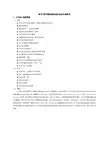
单节/双节线性锂电池充电芯片规格书1、HT6292功能简述1.1、特性● 完全的单节/两节锂离子/锂聚合物电池充电芯片● 极低的热消耗● 集成MOSFET、内置电流检测● 不需要外接反相保护二极管● 0.8%的充电电压精度● 可编程充电电流控制,最大达600mA● 芯片温度热折返保护● NTC 热敏接口监测电池温度● 有无电池检测● LED充电状态指示● 恒压充电电压值可通过外接电阻微调● 可以配置为单节或双节锂电池充电● 短路检测、保护● USB与AC适配器电压输入可选择● 工作环境温度范围:-30℃~70℃● 小型SSOP-16封装1.2、应用● 手持设备,包括医疗手持设备● PDA,移动蜂窝电话及智能手机● 移动仪器,MP3● 自充电电池组● 独立充电器● USB总线供电充电器1.3、概述HT6292为线性锂离子/锂聚合物电池充电芯片,其最低输入电压可低至3.6伏,最大充电电流可达600mA。
HT6292能够编程设计适应各种AC适配器及USB接口。
电池充电分为恒流(CC/Constant Current)、恒压(CV/Constant Voltage)过程,恒流充电电流通过外部电阻决定,最大为600mA。
如果考虑到热扩散问题时,往往使用限流输出的AC适配器,使用HT6292 则可以兼顾线性充电器、开关型充电的优点:充电快,自耗功率小。
HT6292 集成电流热折返保护电路、短路保护,确保充电芯片安全工作。
HT6292可以检测电池是否过放电,并对过放电的电池进行预充电。
HT6292集成NTC热敏电阻接口,可以采集、处理电池的温度信息,保证充电电池的安全工作温度。
HT6292 采用SSOP-16封装。
2、HT6292功能框图图1、HT6292功能框图3、 管脚定义图2、HT6292管脚分布图表1、HT6292管脚描述序号 符号 I/O 描述1 VTRIM - 外接电阻微调满充电压 2&3 VIN I 输入电源4CELLI0:两节锂电池充电 1或悬空:单节锂电池充电5 GND - 地6PDNI芯片使能输入: 0:芯片不工作 1或悬空:芯片工作7TOENI0:取消充电时间限制1或悬空:使能内部充电时间限制8 FAULT O FAULT(GREEN)STATUS(RED)描述0 0 没有充电或者无电池 0 1 正在充电 1 0 充电完成 0 PULSE1 故障状态 9STATUSOPULSE2电池温度异常10 CREF - 振荡器外接电容,决定内部振荡频率,同时提供参考时钟 11 TEMP I 温度传感信号输入12 V33 O 输出3.3V 参考电压,提供10mA 驱动能力 13VSELI0:USB 输入,充电电流为适配器输入时的50% 1或悬空:适配器输入14 RREF - 外接电阻控制恒流充电电流 15&16 VOUTO输出,接锂电池4、HT6292电气特性和推荐工作条件表2、HT6292推荐工作条件参数 最小值 典型值 最大值单位备注电源电压 4.5 5.0 6.5 V 单节电池充电电源电压8.8 10.0 11 V 双节电池充电环境温度-20 70 ℃5、HT6292性能参数表3、HT6292性能参数(一节电池,Ta=25℃)参数 符号 测试条件 最小 典型 最大 单位 上电复位电压上电复位 VPOR 3.6 V Standby模式VOUT漏电流 VBAT=3.7V 20 uA VIN电源电流VOUT悬空、PDN=0 100 uAVOUT悬空、PDN=1或悬空 1 mA 电压调整输出电压 4.158 4.20 4.242 V Dropout电压 200 mV 充电电流恒流充电电流A Icc VRREF>1.3V、VBAT=3.7V540 600 660 mA 预充电电流A Ipre VRREF>1.3V、VBAT=2.0V75 mA 恒流充电电流B Icc VRREF<0.4V、VBAT=3.7V100 mA 预充电电流B Ipre VRREF<0.4V、VBAT=2.0V12 mA 恒流充电电流C Icc RREF=35K、VBAT=3.7V 600 mA 预充电电流C Ipre RREF=35K、VBAT=2.0V 75 mA 再充电、预充电电压预充电阈值电压 Vpre 2.7 2.8 3.0 V 再充电阈值电压 Vrhg 3.95 V 温度监测低温阈值电压高温阈值电压折返阈值 85 100 115 ℃ 折返电流增益 100 mA/℃ 振荡器振荡频率 CREF=20nF 333 Hz 振荡周期 CREF=20nF 2.4 3.0 3.6 mS 逻辑电平逻辑高电平 VH 2 V 逻辑低电平 VL 0.8 V STATUS/FAULT驱动电流 5 mA表4、HT6292性能参数(双节电池,Ta=25℃)参数 符号 测试条件 最小 典型 最大 单位 上电复位电压上电复位 VPOR 6.4 V Standby模式VOUT漏电流 VBAT=7.4V 40 uA VIN电源电流VOUT悬空、PDN=0 100 uAVOUT悬空、PDN=1或悬空 1 mA 电压调整输出电压 8.316 8.40 8.484 V Dropout电压 200 mV 充电电流恒流充电电流A Icc VRREF>1.3V、VBAT=7.4V540 600 660 mA 预充电电流A Ipre VRREF>1.3V、VBAT=4.0V75 mA 恒流充电电流B Icc VRREF<0.4V、VBAT=7.4V100 mA 预充电电流B Ipre VRREF<0.4V、VBAT=4.0V12 mA 恒流充电电流C Icc RREF=35K、VBAT=7.4V 600 mA 预充电电流C Ipre RREF=35K、VBAT=4.0V 75 mA 再充电、预充电电压预充电阈值电压 Vpre 5.4 5.6 6.0 V 再充电阈值电压 Vrhg 7.9 V 温度监测低温阈值电压高温阈值电压折返阈值 85 100 115 ℃ 折返电流增益 100 mA/℃ 振荡器振荡频率 CREF=20nF 333 Hz 振荡周期 CREF=20nF 2.4 3.0 3.6 mS 逻辑电平逻辑高电平 VH 4 V 逻辑低电平 VL 0.4 V STATUS/FAULT驱动电流 5 mA6、HT6292功能描述及管脚应用说明6.1、锂电池充电介绍图3、锂电池充电曲线示意图锂电池充电过程主要分为恒流充电和恒压充电,恒流充电阶段充电电流保持恒定,同时电池电压不断上升。
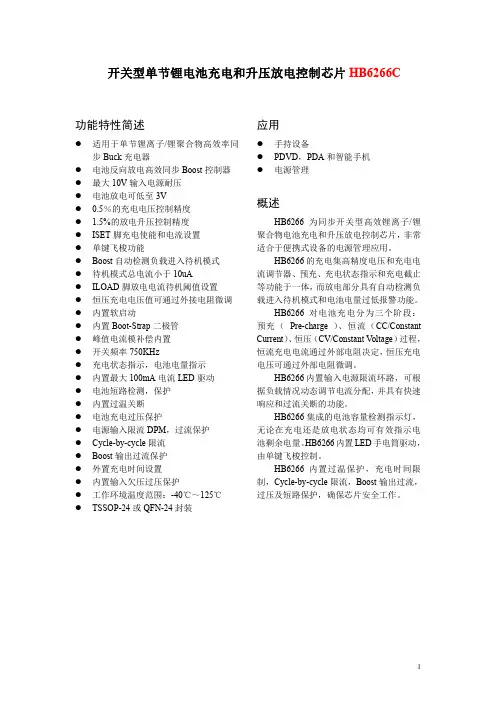
开关型单节锂电池充电和升压放电控制芯片HB6266C功能特性简述●适用于单节锂离子/锂聚合物高效率同步Buck充电器●电池反向放电高效同步Boost控制器●最大10V输入电源耐压●电池放电可低至3V●0.5%的充电电压控制精度● 1.5%的放电升压控制精度●ISET脚充电使能和电流设置●单键飞梭功能●Boost自动检测负载进入待机模式●待机模式总电流小于10uA●ILOAD脚放电电流待机阈值设置●恒压充电电压值可通过外接电阻微调●内置软启动●内置Boot-Strap二极管●峰值电流模补偿内置●开关频率750KHz●充电状态指示,电池电量指示●内置最大100mA电流LED驱动●电池短路检测,保护●内置过温关断●电池充电过压保护●电源输入限流DPM,过流保护●Cycle-by-cycle限流●Boost输出过流保护●外置充电时间设置●内置输入欠压过压保护●工作环境温度范围:-40℃~125℃●TSSOP-24或QFN-24封装应用●手持设备●PDVD,PDA和智能手机●电源管理概述HB6266为同步开关型高效锂离子/锂聚合物电池充电和升压放电控制芯片,非常适合于便携式设备的电源管理应用。
HB6266的充电集高精度电压和充电电流调节器、预充、充电状态指示和充电截止等功能于一体,而放电部分具有自动检测负载进入待机模式和电池电量过低报警功能。
HB6266对电池充电分为三个阶段:预充(Pre-charge)、恒流(CC/Constant Current)、恒压(CV/Constant Voltage)过程,恒流充电电流通过外部电阻决定,恒压充电电压可通过外部电阻微调。
HB6266内置输入电源限流环路,可根据负载情况动态调节电流分配,并具有快速响应和过流关断的功能。
HB6266集成的电池容量检测指示灯,无论在充电还是放电状态均可有效指示电池剩余电量。
HB6266内置LED手电筒驱动,由单键飞梭控制。
HB6266内置过温保护,充电时间限制,Cycle-by-cycle限流,Boost输出过流,过压及短路保护,确保芯片安全工作。
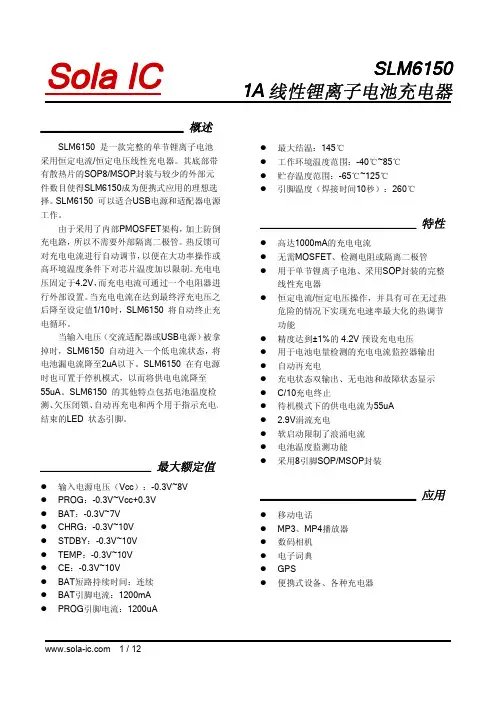
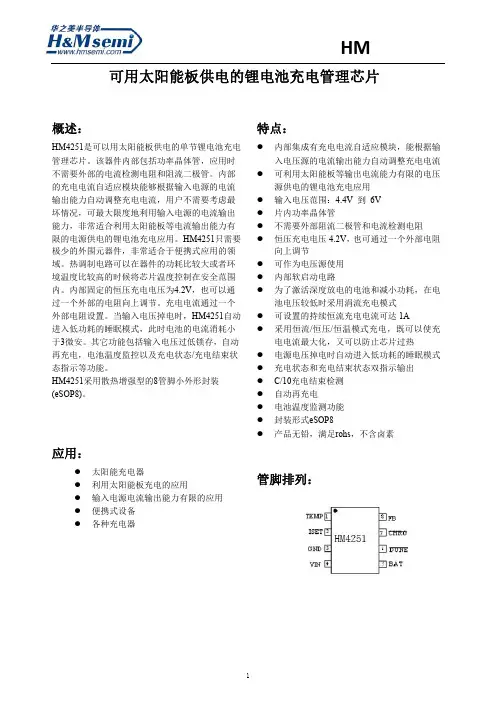
可用太阳能板供电的锂电池充电管理芯片+0概述:HM4251是可以用太阳能板供电的单节锂电池充电管理芯片。
该器件内部包括功率晶体管,应用时不需要外部的电流检测电阻和阻流二极管。
内部的充电电流自适应模块能够根据输入电源的电流输出能力自动调整充电电流,用户不需要考虑最坏情况,可最大限度地利用输入电源的电流输出能力,非常适合利用太阳能板等电流输出能力有限的电源供电的锂电池充电应用。
HM4251只需要极少的外围元器件,非常适合于便携式应用的领域。
热调制电路可以在器件的功耗比较大或者环境温度比较高的时候将芯片温度控制在安全范围内。
内部固定的恒压充电电压为4.2V,也可以通过一个外部的电阻向上调节。
充电电流通过一个外部电阻设置。
当输入电压掉电时,HM4251自动进入低功耗的睡眠模式,此时电池的电流消耗小于3微安。
其它功能包括输入电压过低锁存,自动再充电,电池温度监控以及充电状态/充电结束状态指示等功能。
HM4251采用散热增强型的8管脚小外形封装(eSOP8)。
应用:●太阳能充电器●利用太阳能板充电的应用●输入电源电流输出能力有限的应用●便携式设备●各种充电器特点:●内部集成有充电电流自适应模块,能根据输入电压源的电流输出能力自动调整充电电流●可利用太阳能板等输出电流能力有限的电压源供电的锂电池充电应用●输入电压范围:4.4V 到6V●片内功率晶体管●不需要外部阻流二极管和电流检测电阻●恒压充电电压4.2V,也可通过一个外部电阻向上调节●可作为电压源使用●内部软启动电路●为了激活深度放电的电池和减小功耗,在电池电压较低时采用涓流充电模式●可设置的持续恒流充电电流可达1A●采用恒流/恒压/恒温模式充电,既可以使充电电流最大化,又可以防止芯片过热●电源电压掉电时自动进入低功耗的睡眠模式●充电状态和充电结束状态双指示输出●C/10充电结束检测●自动再充电●电池温度监测功能●封装形式eSOP8●产品无铅,满足rohs,不含卤素管脚排列:HMϰϮϱϭ应用电路:图1 典型应用电路(恒压充电电压4.2V)图2 应用电路(利用外接电阻调整恒压充电电压)在图2中,电池正极端的恒压充电电压为:V REG= 4.2+3.707×10-6×Rx其中,V REG的单位是伏特Rx的单位是欧姆注:当使用外部电阻调整恒压充电电压时,由于芯片内部和外部的温度不一致及芯片生产时的工艺偏差等原因,可能导致恒压充电电压的精度变差和温度系数变大。
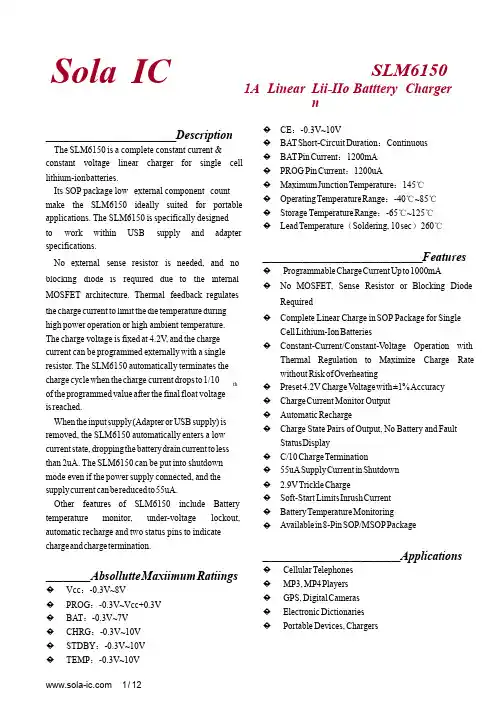
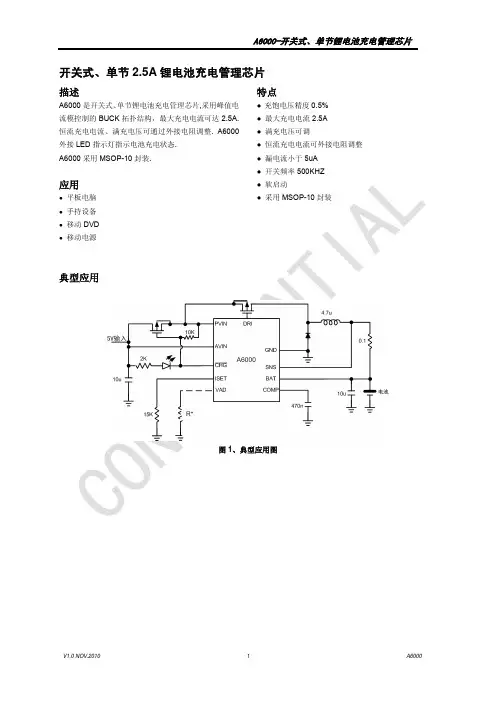

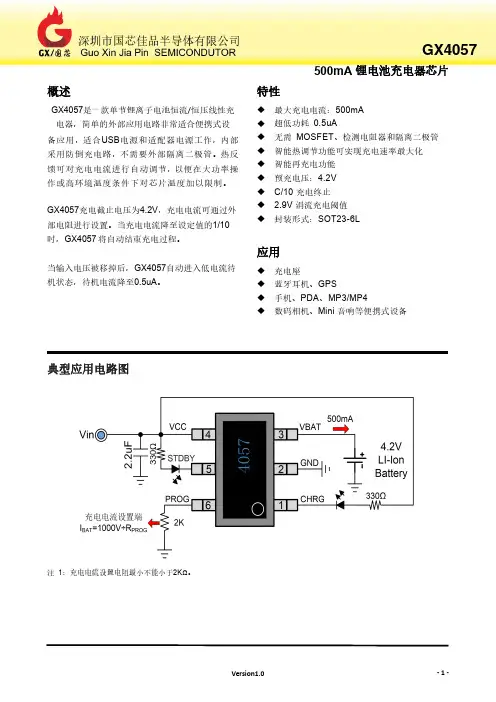
500mA锂电池充电器芯片概述GX4057是一款单节锂离子电池恒流/恒压线性充电器,简单的外部应用电路非常适合便携式设备应用,适合USB电源和适配器电源工作,内部采用防倒充电路,不需要外部隔离二极管。
热反馈可对充电电流进行自动调节,以便在大功率操作或高环境温度条件下对芯片温度加以限制。
GX4057充电截止电压为4.2V,充电电流可通过外部电阻进行设置。
当充电电流降至设定值的1/10时,G X4057将自动结束充电过程。
当输入电压被移掉后,GX4057自动进入低电流待机状态,待机电流降至0.5uA。
特性◆最大充电电流:500mA◆超低功耗0.5uA◆无需MOSFET、检测电阻器和隔离二极管◆智能热调节功能可实现充电速率最大化◆智能再充电功能◆预充电压:4.2V◆C/10充电终止◆ 2.9V涓流充电阈值◆封装形式:SOT23-6L应用◆充电座◆蓝牙耳机、GPS◆手机、PDA、MP3/MP4◆数码相机、Mini音响等便携式设备典型应用电路图注1:充电电流设置电阻最小不能小于2KΩ。
GX4057引脚排列SOT23-6L引脚定义管脚符号描述1CHRG充电状态指示端2GND电源地3VBAT电池正端4VCC充电器正端5STDBY充电完成状态指示端6PROG充电电流设置端内部框架图引脚功能描述CHRG(PIN1):充电状态指示端当充电器向电池充电时,CHRG引脚被内部开关拉到低电平,表示充电正在进行;当充电结束时,CHRG 管脚处于高阻态,插入充电器而没接电池的话指示灯会闪烁提示未接电池或电池接触不好。
GND(PIN2):电源地VBAT(PIN3):电池正端将电池的正端连接到此管脚。
无VCC接入或者电池充满进入待机状态后,BAT管脚的漏电流小于3uA,BAT 管脚向电池提供充电电流和4.2V的充满电压,如果电池未接,则BAT脚悬空电压为4.6V左右。
VCC(PIN4):充电器正端此管脚的电压为内部电路的工作电源。
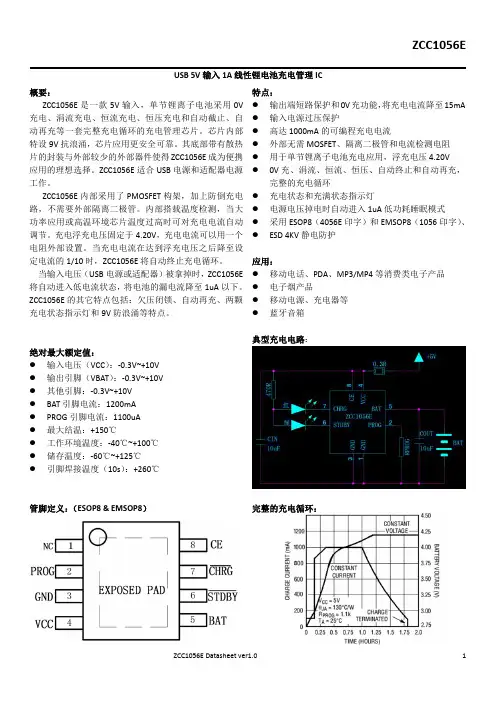
General DescriptionThe MAX1551/MAX1555 charge a single-cell lithium-ion (Li+) battery from both USB* and AC adapter sources.They operate with no external FETs or diodes, and accept operating input voltages up to 7V.On-chip thermal limiting simplifies PC board layout and allows optimum charging rate without the thermal limits imposed by worst-case battery and input voltage. When the MAX1551/MAX1555 thermal limits are reached, the chargers do not shut down, but progressively reduce charging current.The MAX1551 includes a POK output to indicate when input power is present. If either charging source is active, POK goes low. The MAX1555 instead features a CHG output to indicate charging status.With USB connected, but without DC power, charge cur-rent is set to 100mA (max). This allows charging from both powered and unpowered USB hubs with no port communication required. When DC power is connected,charging current is set at 280mA (typ). No input-blocking diodes are required to prevent battery drain.The MAX1551/MAX1555 are available in 5-pin thin SOT23packages and operate over a -40°C to +85°C range.ApplicationsPDAsWireless Appliances Cell Phones Digital CamerasFeatureso Charge from USB or AC Adaptero Automatic Switchover when AC Adapter is Plugged In o On-Chip Thermal Limiting Simplifies Board Design o Charge Status Indicator o 5-Pin Thin SOT23 Packageo Protected by U.S. Patent #6,507,172MAX1551/MAX1555SOT23 Dual-Input USB/AC Adapter 1-Cell Li+Battery Chargers________________________________________________________________Maxim Integrated Products1Ordering Information19-2902; Rev 0; 7/03For pricing, delivery, and ordering information,please contact Maxim/Dallas Direct!at 1-888-629-4642, or visit Maxim’s website at .Pin ConfigurationTypical Operating Circuit*Protected by U.S. Patent #6,507,172.Selector GuideM A X 1551/M A X 1555SOT23 Dual-Input USB/AC Adapter 1-Cell Li+Battery Chargers 2_______________________________________________________________________________________ABSOLUTE MAXIMUM RATINGSELECTRICAL CHARACTERISTICSStresses beyond those listed under “Absolute Maximum Ratings” may cause permanent damage to the device. These are stress ratings only, and functional operation of the device at these or any other conditions beyond those indicated in the operational sections of the specifications is not implied. Exposure to absolute maximum rating conditions for extended periods may affect device reliability.DC to GND......................................................................0 to +8V DC to BAT.......................................................................0 to +7V BAT, CHG , POK , USB to GND.................................-0.3V to +7V Continuous Power Dissipation (T A = +70°C)5-Pin Thin SOT23 (derate 9.1mW/°C above +70°C)....727mWOperating Temperature Range ...........................-40°C to +85°C Junction Temperature Range............................-40°C to +150°C Storage Temperature Range.............................-65°C to +150°C Lead Temperature (soldering, 10s).................................+300°CMAX1551/MAX1555SOT23 Dual-Input USB/AC Adapter 1-Cell Li+Battery Chargers_______________________________________________________________________________________3off when it falls below 3.52V.Note 2:Specifications to -40°C are guaranteed by design, not production tested.ELECTRICAL CHARACTERISTICSM A X 1551/M A X 1555SOT23 Dual-Input USB/AC Adapter 1-Cell Li+Battery Chargers 4_______________________________________________________________________________________Typical Operating Characteristics(V DC = 5V, V USB = 0, I BAT = 0, C BAT = 1µF, T A = +25°C, unless otherwise noted.)CHARGE CURRENTvs. DC VOLTAGE HEADROOMDC VOLTAGE HEADROOM (V DC - V BAT ) (V)C H A R G E C U R R E N T (m A )0.30.20.150100150200250300-500.50.4CHARGE CURRENTvs. USB VOLTAGE HEADROOMUSB VOLTAGE HEADROOM (V USB - V BAT ) (V)C H A R G E C U R R E N T (m A )0.40.30.20.1020406080100-2000.5DC CHARGE CURRENT vs. BATTERY VOLTAGEM A X 1551/55 t o c 03BATTERY VOLTAGE (V)D C C H A R GE C U R R E N T (m A )4.03.53.02.52.01.51.00.5050100150200250300-500 4.5USB CHARGE CURRENT vs. BATTERY VOLTAGEM A X 1551/55 t o c 04BATTERY VOLTAGE (V)U S B C H A R G E C U R R E N T (m A )4.03.53.02.52.01.51.00.5020406080100-204.5DC CHARGE CURRENT vs. AMBIENT TEMPERATURETEMPERATURE (°C)D C C H A R GE C U R R E N T (m A )756555453550100150200250300-502585BATTERY TERMINATION VOLTAGEvs. TEMPERATURETEMPERATURE (°C)B A T T E R Y T E R M I N A T I O N V O L T A G E (V )356010-154.194.204.214.224.18-4085OFF-BATTERY LEAKAGE CURRENTvs. DC INPUT VOLTAGEDC OR USB INPUT VOLTAGE (V)O F F -B A T T E R Y L E A K A G E C U R R E N T (µA )43210.51.01.52.02.5005USB-TO-DC TRANSITION WAVEFORMMAX1551/55 toc08400ms/divV USB 5V/divV DC 5V/div0A0V0V0VBATTERY CURRENT 200mA/divV POK 2V/divDetailed DescriptionThe MAX1551/MAX1555 charge a single-cell Li+ bat-tery from both USB and AC adapter sources, enabling portable users to forgo carrying a wall cube. These devices operate with no external FETs or diodes, and accept operating input voltages up to 7V.An internal thermal control loop simplifies PC board lay-out and allows optimum charging rate without the ther-mal limits imposed by worst-case battery and input voltage. When the MAX1551/MAX1555 thermal limits are reached, the chargers do not shut down, but simply reduce charging current by 17mA/°C above a die tem-perature of +110°C.With USB connected, but without DC power, the charge current is set to 100mA (max). This allows charging from both powered and unpowered USB hubs with no port communication required. When DC power is con-nected, charging current is set at 280mA (typ). The MAX1551/MAX1555 do not feature an enable input.Once power is connected to USB and/or DC, the charger is on.When input power is removed, battery leakage current is less than 5µA. No input-blocking diodes are required to prevent battery drain. Insert a diode at DC (the adapter input) if protection from negative voltage inputs (reversed-polarity adapter plugs) is required.USB to Adapter Power HandoffThe MAX1551/MAX1555 can charge from either the USB input or the DC input. The battery does not charge from both sources at the same time. The MAX1551/MAX1555 automatically detect the active input and charge from that. If both power sources are active, the DC input takes precedence. The switchover between DC and USB is detailed in Table 1.MAX1551 Power-OK (POK )The MAX1551’s POK is an active-low, open-drain out-put that goes low when V DC or V USB is above 3.95V.POK can be used as a logic output or can drive an LED. POK indicates the charger is connected to input power and is charging.MAX1555 Charge Status (CHG )The MAX1555’s CHG is an active-low, open-drain charge status indicator. CHG pulls low when the battery is charging (whenever USB or DC are powered) and charge current is greater than 50mA. CHG indicates when the battery is fully charged by going high imped-ance when the charger is in voltage mode and charge current falls below 50mA. Charging does not stop when CHG goes high. CHG is low in precharge mode.MAX1551/MAX1555SOT23 Dual-Input USB/AC Adapter 1-Cell Li+Battery Chargers_______________________________________________________________________________________5Pin DescriptionTable 1. USB and DC Input SelectionM A X 1551/M A X 1555Precharge CurrentThe MAX1551/MAX1555 feature a precharge current to protect deeply discharged cells. If V BAT is less than 3V,the device enters precharge mode where charging cur-rent is limited to 40mA.Package Thermal LimitingOn-chip thermal limiting in the MAX1551/MAX1555 sim-plifies PC board layout and allows charging rates to be optimized without the limits imposed by worst-case bat-tery and input voltages. The device reduces the power dissipation at BAT to prevent overheating. This allows the board design to be optimized for compact size and typical thermal conditions. When the MAX1551/MAX1555 thermal limits are reached, the chargers donot shut down, but progressively reduce charging cur-rent by 17mA/°C above a die temperature of +110°C.Solder the MAX1551/MAX1555s ’ GND to a large ground plane to help dissipate power and keep the die temperature below the thermal limit. The USB charge current of 100mA is unlikely to induce thermal limiting.Bypass CapacitorsUse ceramic bypass capacitors at DC, USB, and BAT.Mount these capacitors within 1cm of their respective pins. X7R and X5R dielectrics are recommended.Chip InformationTRANSISTOR COUNT: 541PROCESS: BiCMOSSOT23 Dual-Input USB/AC Adapter 1-Cell Li+Battery Chargers 6_______________________________________________________________________________________Typical Application CircuitMAX1551/MAX1555SOT23 Dual-Input USB/AC Adapter 1-Cell Li+Battery ChargersPackage Information(The package drawing(s) in this data sheet may not reflect the most current specifications. For the latest package outline information,go to /packages .)M A X 1551/M A X 1555SOT23 Dual-Input USB/AC Adapter 1-Cell Li+Battery Chargers Maxim c annot assume responsibility for use of any c irc uitry other than c irc uitry entirely embodied in a Maxim produc t. No c irc uit patent lic enses are implied. Maxim reserves the right to change the circuitry and specifications without notice at any time.8_____________________Maxim Integrated Products, 120 San Gabriel Drive, Sunnyvale, CA 94086 408-737-7600©2003 Maxim Integrated ProductsPrinted USAis a registered trademark of Maxim Integrated Products.Package Information (continued)(The package drawing(s) in this data sheet may not reflect the most current specifications. For the latest package outline information,go to /packages.)。
使用说明书充电式LED灯AUAML106中文简体: 原本使用前请阅读。
保留备用。
2146879简体中文(原厂指导手册)规格·鉴于我司将持续实施研发计划,此处规格如有变更,恕不另行通知。
·本产品在各个国家的规格和电池套管可能有所不同。
·视电池类型和使用环境的情况,操作时间可能不同。
·视附件(包括电池套管)的情况,重量可能不同。
最轻和最重的组合(根据 EPTA-Procedure 01/2014)显示在表中。
警告:仅使用以上列出的电池套管。
使用任何其他电池套管和充电器可能会引起受伤或火灾。
符号...请阅读操作手册。
.........仅供室内使用..........请勿凝视工作中的光源。
.........仅欧盟国家请勿将电气设备或电池组与家庭普通废弃物一同丢弃!请务必遵守欧洲关于废弃电子电气设备、电池和蓄电池以及废弃电池和蓄电池的指令并根据法律法规执行。
达到使用寿命的电气设备和电池组必须分类回收至符合环境保护规定的再循环机构。
重要安全指导警告:在使用电动工具时,应始终遵守包括如下内容在内的基本安全注意事项,以降低火灾、触电或人身伤害的风险:阅读所有指导。
1.使用电池套管前,请阅读 (1) 电池充电器、(2) 电池和 (3) 使用电池之产品上的所有指导说明和警戒标记。
2.仅使用制造商指定的充电器进行充电。
适用于一种类型电池组的充电器如果用于其他电池组可能会引起火灾危险。
3.使用充电器铭牌上规定电压的电源。
4.请勿尝试使用升压变压器、引擎发电机或直流电源插座。
5.充电后或进行任何维护或清洁工作前,拔下充电器的电源线。
6.本电池固定器机件不防水。
请勿在湿气重或潮湿的场所中使用。
请勿将其暴露在雨或雪中。
请勿用水冲洗。
7.请勿用镊子、金属工具等接触闪光灯头的内部。
8.如果使用不当可能从电池渗出液体。
避免接触此类流动物体。
如果意外接触到电池漏液,请用水冲洗。
如果上述液体侵入眼睛必须即刻就医。
ME40691节1.8A 开关型锂电池充电器ME4069概述ME4069是一款具有恒流恒压充电模式的锂电池充电管理芯片。
可以对单节(4.2V )锂电池进行快速高效地充电。
其采用电流模式PWM 降压型开关控制结构,为锂电池快速充电提供了微型、简单且高效的解决方案。
ME4069内置防倒灌功能,所以实际应用不需要输入端接二极管防倒灌。
大大降低了系统成本。
芯片内置过压保护功能,当芯片的VIN 电压超过6V 之后,芯片关闭,此时芯片的VIN 端可耐压6V 。
ME4069由外部Sense 电阻设定出高精度的充电电流,内部由分压电阻和精准的参考电压将电池的浮充电压设定在4.2V 同时具有高达±1%的精度。
当输入电源去掉后,芯片会自动进入低电流休眠模式,电池的漏电流低至1μA 。
当充电周期结束后,如果单节电池电压降到4.1V 后,芯片将自动重新对电池进行充电。
特点● 输入电源电压工作范围:4.7V~5.5V ● 内置防倒灌功能● 内置过压保护,过压保护电压值6V 。
● 内置软启动,防止上电瞬间的大电流过冲 ● 高效电流模式PWM 降压型开关控制结构 ● 充电结束时电流检测输出● 采用固定开关频率以保证最小的噪声 ● ±1%的充电电压(4.2V )精度 ● 自动再充电● 输入电源去除自动进入休眠模式 ● 电池电压较低时自动进入涓流充电模式 ● 采用低ESR 的陶瓷电容输出稳定 ● 电池温度检测应用场合● 充电设备 ● 便携式笔记本电脑 ● 手持设备封装形式● 8-pin ESOP8典型应用图注意:虚线框内器件C0是电解电容,在输入热插拔应用中需要加上。
选购指南ME 40 69 X XX G环保标识封装形式 SP :ESOP8浮充电压A :4.2V 产品品种号产品类别号公司标志注:如您需要其他电压值或封装形式的产品,请联系我司销售人员。
产品脚位图ENBATSENSWTEMPCHRGVINGND脚位功能说明芯片功能示意图SENBATTEMPGND绝对最大额定值注意:绝对最大额定值是本产品能够承受的最大物理伤害极限值,请在任何情况下勿超出该额定值。
简述
M1056是一款完整的单级锂离子电池采用恒定电流/恒定电压线性充电器。
其底部带有散热片的SOP-8/MSOP-8封装与较少的外部元件数目使得M1056成为便携式应用的理想选择。
M1056可以适合USB电源和适配器电源工作。
M1056采用了内部PMOSFET架构,加上防倒充电路,所以不需要外部隔离二极管,热反馈可对充电电流进行自动调节,以便在大功率操作或高环境温度条件下对芯片温度加以限制。
充电电压固定于4.2V,而充电电流可通过一个电阻器进行外部设置。
当充电电流在达到最终浮充电压之后降至设定值1/10时,M1056将自动终止充电循环。
当输入电压(交流适配器或USB电源)被拿掉时,M1056自动进入一个低电流状态,将电池漏电流降至2uA以下。
M1056在有电源时也可置于停机模式,以而将供电电流降至50uA。
M1056的其他特点包括电池温度检测、欠压闭锁、自动再充电和两个用于指示充电、结束的LED状态引脚。
特点
高达1000mA的可编程充电电流
无需MOSFET、检测电阻器或隔离二极管
用于单节锂离子电池、采用SOP封装的完整线性充电器
恒定电流/恒定电压操作,并具有可在无过热危险的情况下实现充电速率最大化的热调节功能
精度达到±1%的4.2V预设充电电压·用于电池电量检测的充电电流监控器输出
自动再充电
充电状态双输出、无电池和故障状态显示
C/10充电终止
待机模式下的供电电流为50uA
2.9V涓流充电
软启动限制了浪涌电流
电池温度监测功能
封装: SOP8-PP/MSOP8-PP
应用
移动电话、PDA
MP3、MP4播放器
数码相机
电子词典
GPS
便携式设备、各种充电器
典型应用图。